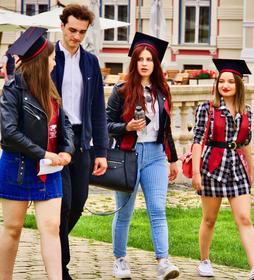- As an aeronautical college that has been training people since 1928, Spartan has an extensive history of contributions to the aviation industry. From the beauty of simple careers that formed the backbone of an industry which is taking us into space, to those leadership positions that are spearheading the advancing technology of the industry, Spartan is well represented all over the world. We have become more than simply a training institution, but also a fellowship. We're a community of those committed to meeting the needs of the ever evolving world of aviation, aerospace, manufacturing, and other related technological fields.
School Highlights
Spartan College of Aeronautics and Technology serves 987 students (100% of students are full-time).
The college's student-teacher ratio of 4:1 is lower than the state community college average of 18:1.
Minority enrollment is 60% of the student body (majority Hispanic and Black), which is more than the state average of 56%.
Quick Facts (2025-26)
- Enrollment: 987 students
- In-state tuition: $16,395
- Out-state tuition: $16,395
- Acceptance Rate: 77%
- Student-teacher ratio: 4:1
- Minority enrollment: 60%
- Source: Integrated Postsecondary Education Data System (IPEDS)
Top Rankings
Spartan College of Aeronautics and Technology ranks among the top 20% of public schools in Oklahoma for:
Category
Attribute
Diversity
School Overview
The teacher population of 257 teachers has stayed relatively flat over five years.
Spartan College of Aeronautics and Technology
(OK) Community College Avg.
Carnegie Classification
Baccalaureate/Associate's Colleges: Mixed Baccalaureate/Associate's
Baccalaureate/Associate's Colleges: Mixed Baccalaureate/Associate's
Institution Level
Less than 2 yrs
At least 2 but less than 4 years
Institution Control
Public
Public
Year Founded
27-Sep-28
Total Faculty
257 staff
184 staff
School Calendar
Student Body
The student population of Spartan College of Aeronautics and Technology has grown by 46% over five years.
The student-teacher ratio of 4:1 has increased from 3:1 over five years.
The Spartan College of Aeronautics and Technology diversity score of 0.77 is more than the state average of 0.76. The school's diversity has stayed relatively flat over five years.
Total Enrollment
987 students
1,856 students
Student-Teacher Ratio
4:1
18:1
# Full-Time Students
987 students
712 students
# Part-Time Students
n/a
1,144 students
# Enrollment Undergraduate
987 students
248 students
# Full-Time Undergraduate Students
987 students
663 students
# Full-Time Graduate Students
n/a
5 students
# Part-Time Undergraduate Students
n/a
1,058 students
# Part-Time Graduate Students
n/a
14 students
Total Dormitory Capacity
n/a
300 students
% American Indian/Alaskan
5%
8%
% Asian
2%
4%
% Hispanic
11%
11%
% Black
8%
10%
% White
40%
44%
% Hawaiian
1%
8%
% Two or more races
5%
10%
% Non Resident races
6%
1%
% Unknown races
21%
4%
Diversity Score
0.77
0.76
College Completion Rate (Students who graduate in less than 4 years)
n/a
54%
College Completion Rate (Students who graduate in 4 years or more than 4 years)
65%
15%
Average Graduate Earnings (10 Years)
$44,800
$34,700
Tuition and Acceptance Rate
The public in-state tuition of $16,395 is more than the state average of $3,475. The in-state tuition has declined by 25% over four years.
The public out-state tuition of $16,395 is more than the state average of $7,963. The out-state tuition has declined by 25% over four years.
In-State Tuition Fees
$16,395
$3,475
Out-State Tuition Fees
$16,395
$7,963
Tuition Notes
Varies by Program
% Students Receiving Some Financial Aid
60%
88%
Median Debt for Graduates
$16,063
$11,000
Median Debt for Dropouts
$8,750
$5,637
Acceptance Rate
77%
55%
SAT Reading
n/a
387
SAT Math
n/a
475
ACT Composite
n/a
18
ACT English
n/a
17
ACT Math
n/a
18
Source: 2024 (or latest year available) Integrated Postsecondary Education Data System (IPEDS) , School Administrators
School Notes
- Spartan has over 247,000 square feet of training facilities on three campuses and located at two Tulsa-area airports. Spartan maintains industry-current equipment to offer hands-on training that prepares students for entry-level career positions. Spartan has over 25 aircraft for technical training and maintains a fleet of over 45 aircraft for flight training. Spartan College of Aeronautics and Technology offers programs in Professional Pilot, Aviation Maintenance, Avionics Maintenance and Quality Control/Nondestructive Testing. Spartan offers associate of applied science degrees, and a bachelor's degree program. Spartan is accredited by the Accrediting Commission of Career Schools and Colleges (ACCSC) and licensed by the Oklahoma Board of Private and Vocational Schools (OBPVS). Most courses are approved by the Oklahoma State Accrediting Agency for Veterans (GI Bill). The Aviation Maintenance Technician Programs and Flight Programs are approved by the Federal Aviation Administration.
Frequently Asked Questions
How much does Spartan College of Aeronautics and Technology cost?
Spartan College of Aeronautics and Technology's tuition is approximately $16,395 for In-State students and $16,395 for Out-State students.
What is the acceptance rate of Spartan College of Aeronautics and Technology?
The acceptance rate of Spartan College of Aeronautics and Technology is 77%, which is higher than the state average of 55%.
What is Spartan College of Aeronautics and Technology's ranking?
Spartan College of Aeronautics and Technology ranks among the top 20% of community college in Oklahoma for: Diversity in US community colleges.
Recent Articles

Community College Success Rates 2025: Outcomes & Trends
Updated 2025 analysis of community college success rates, completion, transfer, costs, enrollment, and strategies that shape student outcomes.

Community Colleges in 2025: Combating Stereotypes with Impact
Updated insights on how community colleges are dispelling myths, growing enrollment, and expanding pathways in 2025.

2025 FAFSA Changes Explained for Community College Students
A comprehensive guide to 2025 FAFSA changes, what community college students must know, new eligibility rules, timelines, and tips to maximize federal aid.










